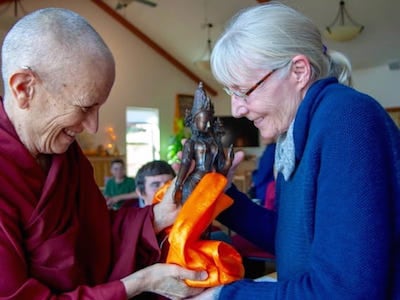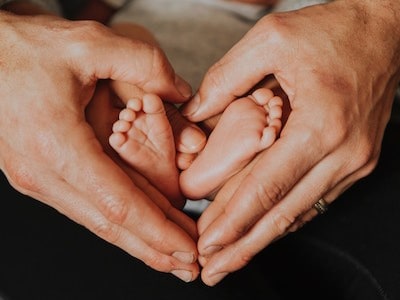The Second Precept: Generosity
Commentary on The Five Wonderful Precepts

Although Thich Nhat Hanh’s expanded interpretation and explanation of the five lay precepts differs from that explained by Venerable Chodron, reading and thinking about his explanation can help broaden our understanding and appreciation for what it means to guard our ethical conduct.
Aware of the suffering caused by exploitation, social injustice, stealing, and oppression, I undertake to cultivate loving kindness and learn ways to work for the well-being of people, animals, plants, and minerals. I undertake to practice generosity by sharing my time, energy, and material resources with those who are in real need. I am determined not to steal and not to possess anything that should belong to others. I will respect the property of others, but I will prevent others from profiting from human suffering or the suffering of other species on Earth.
Exploitation, social injustice, and stealing come in many forms. Oppression is one form of stealing that causes much suffering both here and in the Third World. The moment we undertake to cultivate loving kindness, loving kindness is born in us, and we make every effort to stop exploitation, social injustice, stealing and oppression.
In the First Precept, we found the word “compassion.” Here, we find the words “loving kindness.” Compassion and loving kindness are the two aspects of love taught by the Buddha. Compassion, karuna in Sanskrit and Pali, is the intention and capacity to relieve the suffering of another person or living being. Loving kindness, maitri in Sanskrit, metta in Pali, is the intention and capacity to bring joy and happiness to another person or living being. It was predicted by Shakyamuni Buddha that the next Buddha will bear the name Maitreya, the Buddha of Love.
“Aware of the suffering caused by exploitation, social injustice, stealing, and oppression, I undertake to cultivate loving kindness and learn ways to work for the well-being of people, animals, plants and minerals.” Even with maitri as a source of energy in ourselves, we still need to learn to look deeply in order to find ways to express it. We do it as individuals, and we learn ways to do it as a nation. To promote the well-being of people, animals, plants, and minerals, we have to come together as a community and examine our situation, exercising our intelligence and our ability to look deeply so that we can discover appropriate ways to express our maitri in the midst of real problems.
Suppose you want to help those who are suffering under a dictatorship. In the past you may have tried sending in troops to overthrow their government, but you have learned that when doing that, you cause the deaths of many innocent people, and even then, you might not overthrow the dictator. If you practice looking more deeply, with loving kindness, to find a better way to help these people without causing suffering, you may realize that the best time to help is before the country falls into the hands of a dictator. If you offer the young people of that country the opportunity to learn your democratic ways of governing by giving them scholarships to come to your country, that would be a good investment for peace in the future. If you had done that thirty years ago, the other country might be democratic now, and you would not have to bomb them or send in troops to “liberate” them. This is just one example of how looking deeply and learning can help us find ways to do things that are more in line with loving kindness. If we wait until the situation gets bad, it may be too late. If we practice the precepts together with politicians, soldiers, businessmen, lawyers, legislators, artists, writers, and teachers, we can find the best ways to practice compassion, loving kindness, and understanding.
It requires time to practice generosity. We may want to help those who are hungry, but we are caught in the problems of our own daily lives. Sometimes, one pill or a little rice could save the life of a child, but we do not take the time to help, because we think we do not have the time. In Ho Chi Minh City, for example, there are street children who call themselves “the dust of life.” They are homeless, and they wander the streets by day and sleep under trees at night. They scavenge in garbage heaps to find things like plastic bags they can sell for one or two cents per pound. The nuns and monks in Ho Chi Minh City have opened their temples to these children, and if the children agree to stay four hours in the morning—learning to read and write and playing with the monks and nuns—they are offered a vegetarian lunch. Then they can go to the Buddha hall for a nap. (In Vietnam, we always take naps after lunch; it is so hot. When the Americans came, they brought their practice of working eight hours, from nine to five. Many of us tried, but we could not do it. We desperately need our naps after lunch.)
Then at two o’clock there is more teaching and playing with the children, and the children who stay for the afternoon receive dinner. The temple does not have a place for them to sleep overnight. In our community in France, we have been supporting the nuns and monks. It costs only twenty cents for a child to have both lunch and dinner, and it will keep him from being out on the streets, where he might steal cigarettes, smoke, use delinquent language, and learn the worst behavior. By encouraging the children to go to the temple, we help prevent them from becoming delinquent and entering prison later on. It takes time to help these children, not much money. There are so many simple things like this we can do to help people, but because we cannot free ourselves from our situation and our lifestyle, we do nothing at all. We need to come together as a community, and, looking deeply, find ways to be free ourselves so we can practice the Second Precept.
“I undertake to practice generosity by sharing my time, energy, and material resources with those who are in real need.” This sentence is clear. The feeling of generosity and the capacity for being generous are not enough. We also need to express our generosity. We may feel that we don’t have the time to make people happy – we say, “Time is money,” but time is more than money. Life is for more than using time to make money. Time is for being alive, for sharing joy and happiness with others. The wealthy are often the least able to make others happy. Only those with time can do so.
I know a man named Bac Sieu in Thua Thien Province in Vietnam, who has been practicing generosity for fifty years; he is a living bodhisattva. With only a bicycle, he visits villages of thirteen provinces, bringing something for this family and something for that family. When I met him in 1965, I was a little too proud of our School of Youth for Social Service. We had begun to train three hundred workers, including monks and nuns, to go out to rural villages to help people rebuild homes and modernize local economies, health-care systems, and education. Eventually we had ten thousand workers throughout the country. As I was telling Bac Sieu about our projects, I was looking at his bicycle and thinking that with a bicycle he could help only a few people. But when the communists took over and closed our School, Bac Sieu continued, because his way of working was formless. Our orphanages, dispensaries, schools, and resettlement centers were all shut down or taken by the government. Thousands of our workers had to stop their work and hide. But Bac Sieu had nothing to take. He was truly a bodhisattva, working for the well-being of others. I feel more humble now concerning the ways of practicing generosity.
The war created many thousands of orphans. Instead of raising money to build orphanages, we sought people in the West to sponsor a child. We found families in the villages to each take care of one orphan, then we sent $6 every month to that family to feed the child and send him or her to school. Whenever possible, we tried to place the child in the family of an aunt, an uncle, or a grandparent. With just $6, the child was fed and sent to school, and the rest of the children in the family were also helped. Children benefit from growing up in a family. Being in an orphanage can be like being in the army—children do not grow up naturally. If we look for and learn ways to practice generosity, we will improve all the time.
“I am determined not to steal and not to possess anything that should belong to others. I will respect the property of others, but I will prevent others from profiting from human suffering or the suffering of other species on Earth.” When you practice one precept deeply, you will discover that you are practicing all five. The First Precept is about taking life, which is a form of stealing—stealing the most precious thing someone has, his or her life. When we meditate on the Second Precept, we see that stealing, in the forms of exploitation, social injustice, and oppression, are acts of killing—killing slowly by exploitation, by maintaining social injustice, and by political and economic oppression. Therefore, the Second Precept has much to do with the precept of not killing. We see the “interbeing” nature of the first two precepts. This is true of all Five Precepts. Some people formally receive just one or two precepts. I didn’t mind, because if you practice on or two precepts deeply, all Five Precepts will be observed.
The Second Precept is not to steal. Instead of stealing, exploiting, or oppressing, we practice generosity. In Buddhism, we say there are three kinds of gifts. The first is the gift of material resources. The second is to help people rely on themselves, to offer them the technology and know-how to stand on their own feet. Helping people with the Dharma so they can transform their fear, anger, and depression belongs to the second kind of gift. The third is the gift of non-fear. We are afraid of many things. We feel insecure, afraid of being alone, afraid of sickness and dying. To help people not be destroyed by their fears, we practice the third kind of gift-giving.
The Bodhisattva Avalokitesvara is someone who practices this extremely well. In the Heart Sutra, he teaches us the way to transform and transcend fear and ride on the waves of birth and death, smiling. He says that there is no production, no destruction, no being, no nonbeing, no increasing, and no decreasing. Hearing this helps us look deeply into the nature of reality to see that birth and death, being and nonbeing, coming and going, increasing and decreasing are all just ideas that we ascribe to reality, while reality transcends all concepts. When we realize the interbeing nature of all things—that even birth and death are just concepts—we transcend fear.
In 1991, I visited a friend in New York who was dying, Alfred Hassler. We had worked together in the peace movement for almost thirty years. Alfred looked as though he had been waiting for me to come before dying, and he died only a few hours after our visit. I went with my closest colleague, Sister Chan Khong (True Emptiness).
Alfred was not awake when we arrived. His daughter Laura tried to wake him up, but she couldn’t. So I asked Sister Chan Khong to sing Alfred the Song of No Coming and No Going: “These eyes are not me, I am not caught by these eyes. This body is not me, I am not caught by this body. I am life without boundaries. I have never been born, I will never die.” The idea is taken from Samyutta Nikaya. She sang so beautifully, and I saw streams of tears running down the faces of Alfred’s wife and children. They were tears of understanding, and they were very healing.
Suddenly, Alfred came back to himself. Sister Chan Khong began to practice what she had learned from studying the sutra The Teaching Given to the Sick. She said, “Alfred, do you remember the times we worked together?” She evoked many happy memories we had shared together, and Alfred was able to remember each of them. Although he was obviously in pain, he smiled. This practice brought results right away. When a person is suffering from so much physical pain, we sometimes can alleviate his suffering by watering the seeds of happiness that are in him. A kind of balance is restored, and he will feel less pain.
All the while, I was practicing massage on his feet, and I asked him whether he felt my hand on his body. When you are dying, areas of your body become numb, and you feel as if you have lost those parts of your body. Doing massage in mindfulness, gently, gives the dying person the feeling that he is alive and being cared for. He knows that love is there. Alfred nodded, and his eyes seemed to say, “Yes, I feel your hands. I know my foot is there.”
Sister Chan Khong asked, “Do you know we learned a lot from you when we lived and worked together? The work you began, many of us are continuing to do. Please don’t worry about anything.” She told him many things like that, and he seemed to suffer less. At one point, he opened his mouth and said, “Wonderful, wonderful.” Then he sank back to sleep.
Before we left, we encouraged the family to continue these practices. The next day I learned that Alfred passed away just five hours after our visit. This was a kind of gift that belongs to the third category. If you can help people feel safe, less afraid of life, people, and death, you are practicing the third kind of gift.
During my meditation, I had a wonderful image—the shape of a wave, its beginning and its end. When conditions are sufficient, we perceive the wave, and when conditions are no longer sufficient, we do not perceive the wave. Waves are only made of water. We cannot label the waves as existing or nonexisting. After what we call the death of the wave, nothing is gone, nothing is lost. The wave has been absorbed into other waves, and somehow, time will bring the wave back again. There is no increasing, decreasing, birth, or death. When we are dying, if we think that everyone else is alive and we are the only person dying, our feeling of loneliness may be unbearable. But if we are able to visualize hundreds of thousands of people dying with us, our dying may become serene and even joyful. “I am dying in community. Millions of living beings are also dying in this very moment. I see myself together with millions of other living beings; we die in the Sangha. At the same time, millions of beings are coming to life. All of us are doing this together. I have been born, I am dying. We participate in the whole event as a Sangha.” That is what I saw in my meditation. In the Heart Sutra, Avalokitesvara shares this kind of insight and helps us transcend fear, sorrow, and pain. The gift of non-fear brings about a transformation in us.
The Second Precept is a deep practice. We speak of time, energy, and material resources, but time is not only for energy and material resources. Time is for being with others—being with a dying person or with someone who is suffering. Being really present for even five minutes can be a very important gift. Time is not just to make money. It is to produce the gift of Dharma and the gift of non-fear.
More on The Five Wonderful Precepts
- The Five Wonderful Precepts: Introduction
- The First Precept: Reverence for Life
- The Third Precept: Sexual Responsibility
- The Fourth Precept: Deep Listening and Loving Speech
- The Fifth Precept: Diet for a Mindful Society
© 1993 Reprinted from “For a Future to Be Possible” (First Edition) by Thich Nhat Hanh with permission of Parallax Press.
Thich Nhat Hanh
Zen Master Thich Nhat Hanh was a global spiritual leader, poet and peace activist, revered throughout the world for his powerful teachings and bestselling writings on mindfulness and peace. His key teaching is that, through mindfulness, we can learn to live happily in the present moment—the only way to truly develop peace, both in one’s self and in the world. He passed away in January, 2022. Learn more...


